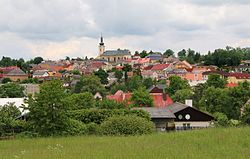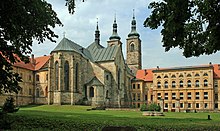
Znojmo is a town in the South Moravian Region of the Czech Republic. It has about 34,000 inhabitants. Znojmo is the historical and cultural centre of southwestern Moravia and the second most populated town in the South Moravian Region. The historic centre of Znojmo is well preserved and is protected by law as an urban monument reservation.

Mnichovo Hradiště is a town in Mladá Boleslav District in the Central Bohemian Region of the Czech Republic. It has about 9,000 inhabitants. The historic town centre is well preserved and is protected by law as an urban monument zone.

Kadaň is a town in Chomutov District in the Ústí nad Labem Region of the Czech Republic. It has about 18,000 inhabitants. It lies on the banks of the Ohře river. Kadaň is a tourist centre with highlights being the Franciscan Monastery and the historical square with late Gothic Town Hall Tower. The historic town centre is well preserved and is protected by law as an urban monument reservation.

Rumburk is a town in Děčín District in the Ústí nad Labem Region of the Czech Republic. It has about 11,000 inhabitants. It lies on the border with Germany.

Sokolov is a town in the Karlovy Vary Region of the Czech Republic. It has about 22,000 inhabitants.

Chodov is a town in Sokolov District in the Karlovy Vary Region of the Czech Republic. It has about 13,000 inhabitants.

Lázně Kynžvart is a spa town in Cheb District, Karlovy Vary Region, Czech Republic. It has about 1,400 inhabitants. It is known for the Kynžvart Castle.

Hroznětín is a town in Karlovy Vary District in the Karlovy Vary Region of the Czech Republic. It has about 2,100 inhabitants.

Nejdek is a town in Karlovy Vary District in the Karlovy Vary Region, Czech Republic. It has about 7,600 inhabitants.

Planá is a town in Tachov District in the Plzeň Region of the Czech Republic. It has about 5,700 inhabitants. The historic town centre is well preserved and is protected by law as an urban monument zone.

Letovice is a town in Blansko District in the South Moravian Region of the Czech Republic. It has about 7,200 inhabitants.

Horní Slavkov is a town in Sokolov District in the Karlovy Vary Region of the Czech Republic. It has about 5,400 inhabitants. The historic town centre is well preserved and is protected by law as urban monument zone.

Bečov nad Teplou is a town in Karlovy Vary District in the Karlovy Vary Region of the Czech Republic. It has about 900 inhabitants. The historic town centre is well preserved and is protected by law as urban monument zone.

Bochov is a town in Karlovy Vary District in the Karlovy Vary Region of the Czech Republic. It has about 1,900 inhabitants.

Chyše is a town in Karlovy Vary District in the Karlovy Vary Region of the Czech Republic. It has about 600 inhabitants.

Plesná is a town in Cheb District in the Karlovy Vary Region of the Czech Republic. It has about 1,900 inhabitants.

Toužim is a town in Karlovy Vary District in the Karlovy Vary Region of the Czech Republic. It has about 3,500 inhabitants. The historic town centre is well preserved and is protected by law as urban monument zone.

Dolní Žandov is a municipality and village in Cheb District in the Karlovy Vary Region of the Czech Republic. It has about 1,200 inhabitants.

Krásné Údolí is a town in Karlovy Vary District in the Karlovy Vary Region of the Czech Republic. It has about 400 inhabitants.

Žlutice is a town in Karlovy Vary District in the Karlovy Vary Region of the Czech Republic. It has about 2,200 inhabitants. The historic town centre is well preserved and is protected by law as urban monument zone.

























